Dissolution Testing For Inhaled Drugs
Pharmaceutical Technology Europe
Although there are no regulatory requirements or established pharmacopoeial techniques for the dissolution testing of inhaled drugs, such testing can potentially open up the opportunity to tailor formulation properties.
Although there are no regulatory requirements or established pharmacopoeial techniques for the dissolution testing of inhaled drugs, such testing can potentially open up the opportunity to tailor formulation properties. The authors explain how a new technique using standard dissolution test equipment in combination with US Pharmacopeia methods for the dissolution testing of solid dosage forms can be used to differentiate the solubility of orally inhaled products.

GEORGE DOYLE/GETTY IMAGES.
Dissolution testing of inhaled drugs is of significant interest to the developers of orally inhaled products (OIPs) that deposit solid particles in the lung. As yet, there is no regulatory requirement or established pharmacopoeial technique for such testing, but its relevance is clear; understanding and, in the longer term, learning to control the dissolution rate of an active (particularly one for systemic therapy) opens up the possibility of tailoring formulation properties, as well as dosing levels and frequencies, for improved drug efficacy and patient compliance.
Against this background, research has been conducted to establish a suitable method for dissolution testing of inhaled products. This paper considers the need for this and describes a technique developed at the University of Texas at Austin (TX, USA). Based on using standard USP dissolution test equipment for solid dosage forms, this new technique differentiates the solubility of OIPs.
Assessing the need for dissolution testing for inhaled drugs
For solid oral dosage forms, such as tablets and capsules, dissolution testing is standardised and routine. The dissolution profile of a product guides formulation and development, and is a widelyused QC tool. Dissolution data may also be used to support claims of parity in a generic product and/or to demonstrate equivalence following a formulation change since it is sufficiently sensitive to identify outofspecification manufactured batches.
With orally inhaled products (OIPs), the efficiency of drug delivery is linked with the extent of deposition in the respiratory tract. A particle size of less than 5 µm is usually regarded as optimal for penetration to the deep lung, so the focus is to develop device/formulation combinations that deliver a high proportion of the dose in this size range: a high fine particle dose (FPD).1
As with solid dosage forms, the therapeutic effect of an inhaled powder is realised via dissolution and subsequent absorption. Powders delivered to the lung are, of necessity, extremely fine, so there may be an assumption that dissolution rates are rapid enough to have little impact on the overall process of drug delivery. Within a recent USP Pharmacopeial Forum review,2 however, it was recognised that dissolution testing may expand our understanding of inhaled drug delivery and support the development of new OIPs. This view is reinforced by industrial interest in the topic, as exemplified by recent work presented by GlaxoSmithKline contrasting the dissolution profile of a longacting beta agonist with that of an inhaled corticosteroid.3 If inhalation technologies follow the same development trajectory as tablets, there is no reason why the modification of particle properties, such as size, shape or crystal habit, to control in vivo release rate should not become routine. Formulations based on liposome, micelle and microsphere technologies also provide for more closely tailored delivery profiles.4,5 The trend towards the pulmonary route for the delivery of systemic drugs strengthens the impetus for refining OIP performance in this way.
Understanding the requirements for OIP dissolution testing
From a practical viewpoint, in vitro dissolution testing for inhalable products should be able to distinguish between samples in a way that replicates trends found in vivo. This suggests that test conditions should reflect the pulmonary environment. Perfectly designed for absorption, the lungs are not ideal from the point of view of dissolution, with fluid levels in the region of 10 to 20 mL/100 m2 of surface. Such small amounts of liquid are likely to be stagnant, inhibiting dissolution. Also, the exact composition of the aqueous fluids and surfactants lining the respiratory tract is not accurately known,6 which complicates the selection of a test medium.
Equally importantly, testing must also consider the delivery characteristics of OIPs. Just a portion of the emitted dose, the FPD, enters the lung so dissolution testing of the whole dose is inappropriate. A better aim is to access the dissolution profile of only those particles that will deposit in the lung.
Developing a dissolution testing technique for inhalable formulations
In 2003, Feddah and Davies introduced a dissolution testing technique for inhalable formulations based on a flow through apparatus.7 This technique involves the use of an Andersen cascade impactor (ACI) to capture the emitted dose from the DPI. A glass fibre filter mounted at the base of a USP induction port, of the type routinely used with multistage cascade impactors, captures the dose during otherwise standard operation of the ACI. Once captured, the dose is held in a dissolution cell through which solvent is pumped at a known flow rate.
This method was used to differentiate the solubility of glucocorticoids employed in the treatment of pulmonary disease, but it has a number of disadvantages. Firstly, although an ACI was used to capture the dose for testing, the size fractionation capabilities of the impactor were not exploited — the entire emitted dose was captured. Therefore, the recorded dissolution behaviour does not relate to just those particles fine enough to deposit in the lung. An additional problem is the amount of solvent used in flow through testing, which is significant; no attempt is made to simulate the sparing presence of lung surfactant in vivo. Furthermore, recorded solubility is dependent on the flow rate of solvent selected, making it too easy to achieve noncomparable results for "zero order" drug solubility.
To address these issues and improve test sensitivity, researchers at the University of Texas have developed a dissolution test for OIP formulations based on the standard "Paddle over Disc" method described in US Pharmacopeia Method 5 and European Pharmacopoeia 2.9.4.8,9 A modified version of this solution is now commercially available (Figure 1). To ensure analysis only of the portion of interest in the emitted dose, the apparatus enables preseparation and sample collection using a Next Generation Impactor (NGI), one of the systems of choice for routine aerodynamic particle size distribution (APSD) measurement.
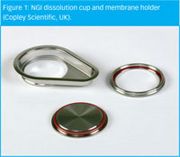
Figure 1: NGI dissolution cup and membrane holder (Copley Scientific, UK).
Multistage cascade impactors, such as the NGI and ACI, separate the emitted dose from an OIP into fractions on the basis of aerodynamic particle size. Using the NGI, these fractions are captured in collection cups. The NGI dissolution cup (Copley Scientific, UK) is almost identical to a standard NGI cup except that it has a 50 mm removable insert in the impaction area where separated sample collects. It fits directly into positions 2 through 7 in a standard NGI cup tray.
To collect a dose for dissolution testing the NGI is operated exactly as for routine APSD measurement, but with the dissolution cup installed at the stage of interest to allow capture of only the size fraction of interest rather than the entire emitted dose. Once collection is complete, the insert is simply removed from the cup and covered with a pre-punched 55 mm diameter polycarbonate membrane. Securing this in place with the supplied membrane holder forms a sealed disc or sandwich that can be placed in a vessel of a conventional dissolution tester (Figure 2). Dissolution testing can then be conducted in an exactly analogous way as for other solid dosage forms, using appropriate operating conditions.
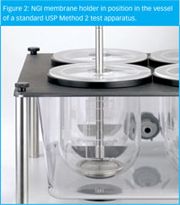
Figure 2: NGI membrane holder in position in the vessel of a standard USP Method 2 test apparatus.
Selection of an appropriate diffusion barrier for testing was crucial to the success of this solution. Although relatively thin (approximately 6 µm), the polycarbonate membrane is robust with properties superior to those of a cellulose acetate alternative used in prototype studies. The chosen membrane neither swells nor creates air bubbles, and has non-tortuous cylindrical pores of well-defined size. These allow free diffusion of both the dissolved drug and dissolution media, enabling dissolution testing under relevant hydrodynamic conditions.
Optimising a dissolution test method for inhalation formulations
Through a series of experiments, factors associated with each step of the test process — from dose collection through to solution sampling method — were investigated to develop an optimal test procedure for use with this new apparatus.10 The following discussion tracks the experiment path taken and its outcome.
Tests to establish optimal conditions were carried out using budesonide (BD) and albuterol sulphate (AS), which are routinely used to treat asthma. BD and AS were fired into the NGI with a Pulmicort Flexhale DPI (AstraZeneca) and Ventolin HFA MDI (GlaxoSmithKline), respectively. Multiple actuations ensured the presence of sufficient sample on the collection surface in initial tests; however, the actuation number was one of the variables investigated as part of the experimental programme.
The test flow rate through the NGI was set at 30 L/min for the Ventolin HFA and 60 L/min for the Pulmicort Flexhaler. These air flow rates were established with reference to pharmacopeial monographs for the testing of MDIs and DPIs.11,12 The monographs stipulate that the flow rate should be set to 30 L/min when testing an MDI (using the NGI) and at a flow rate to give a pressure drop across the device of 4 kPa when testing a DPI. Calibration data for the NGI allows the accurate determination of stage cutoff diameters at both of these flow rates.13
Following size fractionation of the sample in the NGI, the removable impaction surface from the dissolution cup was covered with a polycarbonate membrane (pre-soaked in dissolution fluid) and secured in the membrane holder. This entire assembly was then placed at the bottom of a vessel of a standard USP Method 2 apparatus containing 300 mL of dissolution fluid.
During dissolution testing, 3 mL samples were periodically withdrawn from the vessel for analysis using a validated HPLC method. A corresponding volume of fresh dissolution medium was added after each extraction. With the BD, sample testing took place over a period of 2 h, while 1 h proved sufficient for AS. At the end of the experiment, the residual material on the membrane was recovered and quantified.
Selecting an optimal collection surface for dose collection
Using the dissolution cup it is possible to select one fraction with which to compare one drug to another, or to assess the influence of particle size on dissolution rate by testing different fractions of the dose. With the Pulmicort Flexhaler (BD) stage 4 consistently displayed the maximum deposition while for the Ventolin HFA (AS) it was stage 5. These stages were therefore selected for dose collection for subsequent tests. Stage 4 has a cutoff diameter of 1.66 µm at 60 L/min, while stage 5 has a cut-off diameter of 1.36 µm at an air flow rate of 30 L/min.
For the BD, dissolution profiles were determined as a function of particle size by collecting samples on stage 2 through 5 (Figure 3). Eighty percent of the samples collected on stages 2, 3 and 4 dissolved after 15 min, but there were differences in initial dissolution rates. Statistical analysis shows similarity factors* of 52.5 and 59.7 for stages 2 and 3 compared with stage 4 (the reference stage), but the dissolution profile for stage 5 is significantly different (a similarity factor of 40.6). The smaller particles on this stage, which has a cut-off diameter of 0.94 µm, have a large surface area to volume ratio and, therefore, might be expected to exhibit a faster dissolution rate in accordance with the standard NoyesWhitney model.

Figure 3: Exploring the influence of particle size on dissolution profile for budesonide.
Optimising the speed of rotation of the paddle
Experiments were carried out at paddle rotation speeds of 50, 75 and 100 rpm. With this dissolution apparatus 50 rpm is the norm; however, the presence of the membrane holder necessitated an increase to 75 rpm because of the 'dead' volume between the membrane holder and the base of the vessel, where stagnation could occur after volumes are withdrawn and replaced during the sampling procedure.
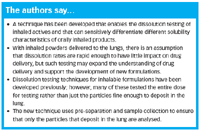
The authors sayâ¦
Investigating the impact of drug loading
Varying the number of actuations during testing permits investigation of the impact of drug loading on dissolution behaviour. For BD, increasing drug loading from 30 to 220 µg by increasing the number of actuations of the device during sample collection has a marked influence on dissolution behaviour. On the other hand, AS dissolves rapidly even at high drug loadings (Figure 4).
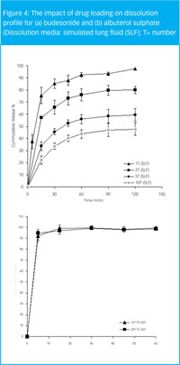
Figure 4: The impact of drug loading on dissolution profile for (a) budesonide and (b) albuterol sulphate (Dissolution media: simulated lung fluid (SLF); T= number
Increasing the thickness of the drug layer increases the amount of diffusion/dissolution activity required to release the entire dose from beneath the membrane since the wetting and dissolution processes proceed inwards layer by layer. This has a marked effect with the hydrophobic BD increasing the obstacles to dissolution, but with the hydrophilic AS this is not the case. This suggests that powder wetting within the membrane holder may be an issue in certain circumstances, especially with hydrophobic or poorly soluble formulations.
A simple solution to this problem is to use just a single actuation to obtain the thinnest possible layer of sample for analysis. The practicality of this approach, however, depends on the limits of detection of the HPLC method for a given solvent/drug formulation. In some cases, it will be necessary to use multiple actuations simply to obtain sufficient drug to enable detection in the extracted samples. An alternative is to consider modification of the dissolution media within the constraint of reflecting the composition of fluids present in the lung.
Assessing different dissolution media
In the first instance, dissolution profiles for BD were measured using three solvents: simulated lung fluid (SLF); 0.2M phosphate buffer (pH 7.4); and phosphate buffered saline (PBS) (Figure 5). There are currently no pharmacopoeial suggested components for artificial lung fluid and it is not feasible to exactly mimic conditions in the lung; rather, the aim during this phase of the study was to identify an appropriate, practical fluid that would simplify testing within the constraint of maintaining relevance.
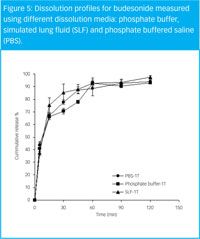
Figure 5: Dissolution profiles for budesonide measured using different dissolution media: phosphate buffer, simulated lung fluid (SLF) and phosphate buffered saline (PBS).
The concept of SLF was introduced by Moss and the solution is described as being similar to actual lung fluid in terms of ionic composition and pH, the full composition can be found at the original reference.6 Unfortunately SLF has low pH buffering capacity and its pH varies significantly with time (over a 24 h period) unless carbon dioxide is continuously bubbled through. There was a possibility that a flow through system might theoretically help to alleviate the issue of low pH buffering capacity, but at the time of the experiments this speculation was wholly unproven. Therefore, the other dissolution media assessed were considered to be a more practical choice, especially for pH-sensitive or slowly dissolving formulations.
For the assessment of different dissolution media, the DPI was fired just once during each sample collection. The similarity factors for PBS and phosphate buffer are 63.4 and 56.1, respectively, compared with SLF suggesting that either is a suitable substitute.
To address the issue of poor wettability with the hydrophobic BD, further trials were carried out, incorporating surfactant into the dissolution media. The results for two modified PBS solutions are shown in Figure 6: mPBS contains dipalmitoylphosphatidylcholine (DPPC), tPBS contains polysorbate 80. DPPC is one of the main components of lung surfactant and lowers surface tension at the air–water interface by forming a monolayer. Here, however, the results suggest that DPPC has little impact on dissolution behaviour, with polysorbate 80 proving much more effective. DPPC forms liposomal aggregates in aqueous media that have a larger particle size distribution than the membrane pore size.14 It is therefore likely that the DPPC has little effect because it cannot penetrate through the membrane to the sample.
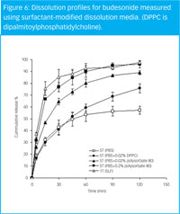
Figure 6: Dissolution profiles for budesonide measured using surfactant-modified dissolution media. (DPPC is dipalmitoylphosphatidylcholine).
Using polysorbate 80 at an appropriate concentration (0.2%), on the other hand, brings the dissolution profile obtained with a sample loading equating to five actuations close to that obtained with no surfactant, and just a single firing of the device. A single actuation produces a very thin drug layer with negligible resistance to wetting and dissolution. These results suggest that the use of tPBS eliminates the issue of wetting for this particular hydrophobic active.
Conclusion
The possibility of tailoring release profiles of OIP formulations for more controlled in vivo delivery brings with it the need for dissolution testing for inhaled actives. Researchers at the University of Texas have developed a possible solution to meet this need that involves collection of a suitable dose using an NGI followed by dissolution testing with standard USP method 5 equipment (paddle over disc). Subsequent development into a commercially available product provides a solution for exploration of the solubility of OIP formulations. The NGI dissolution cup enables capture of that fraction of the emitted dose of interest for dissolution studies; the associated membrane holder presents the sample in an ideal form for "paddle over disc" testing.
Using this novel apparatus, experimental studies were carried out to investigate the influence of different parameters on the measured dissolution profiles of BD and AS. These tests highlight the ability of the technique to sensitively differentiate the different solubility characteristics of OIP formulations, but also underline the importance of considering variables such as drug loading and dissolution media composition in the development of appropriate test procedures.
* Statistical differences between release rates were compared using a similarity factor. This is an established, relatively simple technique for comparing the similarity of different dissolution profiles. While the authors have not included a full description of the method here, reference 15 provides significant detail. Generally speaking, a similarity factor of between 50 and 100 indicates sameness of equivalence in the two curves. Figures of less than 50 suggest a marked difference.
Acknowledgement
This article has been developed using figures in a paper published in Dissolution Technologies. The authors would like to thank the editorial advisory board of Dissolution Technologies for permission to use material from the paper, available at www.dissolutiontech.com.
Mark Copley is Sales Director at Copley Scientific, Colwick, Nottingham UK NG4 2JY.Tel. +44 (0)115 961 6229 m.copley@copleyscientific.co.uk
Yoen-Ju Son is Visiting Research Scientist at College of Pharmacy, University of Texas at Austin (TX, USA).
Jason McConville is Assistant Professor, Director of InstrUcTex, at College of Pharmacy, University of Texas at Austin (TX, USA)
References
1. European Pharmacopoeia 6.0, Section 2.9.18 'Preparations for inhalation: aerodynamic assessment of fine particles' p.299 (2008).
2. V.A. Gray et al., Pharmacopeial Forum, 34(4) (2008).
3. T. Riley et al., In vitro method for determining the dissolution rate of inhalation aerosols at Respiratory Drug Delivery (May 2008; AZ, USA).
4. R.J. Mayank and M. Ambikanandhan, AAPS PharmSciTech, 2(4) article 25 (2001).
5. T.B. Patel, pharmainfo.net, 5(4) (2007).
6. O.R. Moss, Health Physics, 36, 447–448 (1979).
7. N.M. Davies and M.R. Feddah, Int J Pharm., 255(1-2), 175–187 (2003).
8. YJ. Son and J.T. McConville, Development of a standardized dissolution test for inhalable formulations at Respiratory Drug Delivery (May 2008; AZ, USA).
9. YJ. Son and J.T. McConville, Inhalation,2(6) (2008).
10. YJ. Son et al., Dissolution Technologies, 17(2), 6–13 (2010).
11. US Pharmacopeia Volume 1, Apparatus 5 for Dry Powder Inhalers, p.216–220 (2009).
12. European Pharmacopoeia 6.0, Section 2.9.18: Apparatus E: Procedure for powder inhalers p. 297–300 (2008).
13. V.Marple et al., Journal of Aerosol Medicine, 16(3), 301–324 (2003).
14. M. A. Launois-Surpas et al.,Colloid Polym. Sci., 270(9), 901–911 (1992).
15. V.P. Shah et al.,Dissolution Technologies, 15(6), 889–896 (1998). www.dissolutiontech.com/DTresour/899Art/DissProfile.html

Pharmaceutical Tariffs Are Imminent: How Industry is Bracing for Impact
April 16th 2025On April 14, 2025, the Trump Administration launched a national security-driven investigation into pharmaceuticals, a move that will likely result in tariffs being placed on pharmaceutical drugs, ingredients, and other components that are imported from outside of the United States.
Drug Solutions Podcast: A Closer Look at mRNA in Oncology and Vaccines
April 30th 2024In this episode fo the Drug Solutions Podcast, etherna’s vice-president of Technology and Innovation, Stefaan De Koker, discusses the merits and challenges of using mRNA as the foundation for therapeutics in oncology as well as for vaccines.